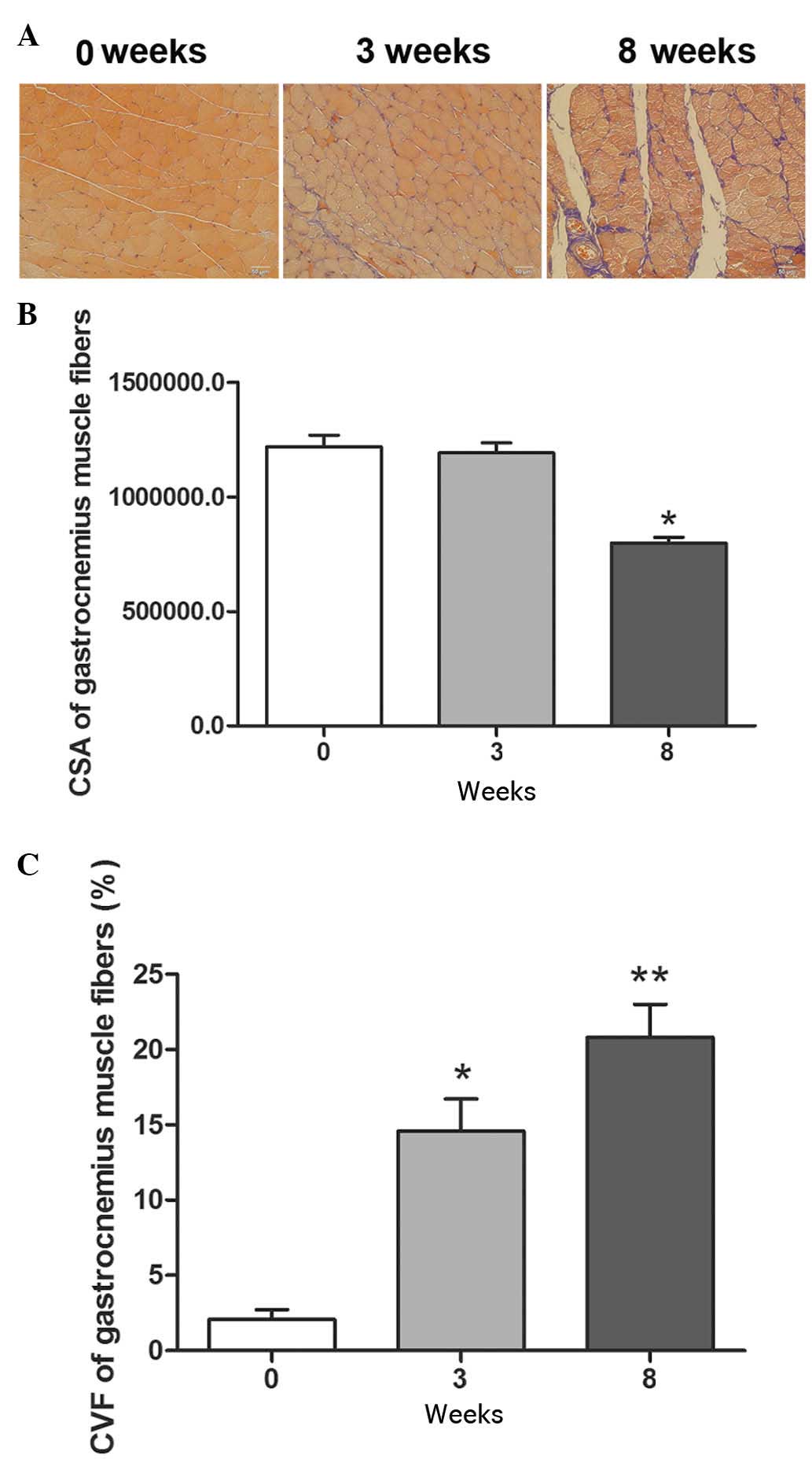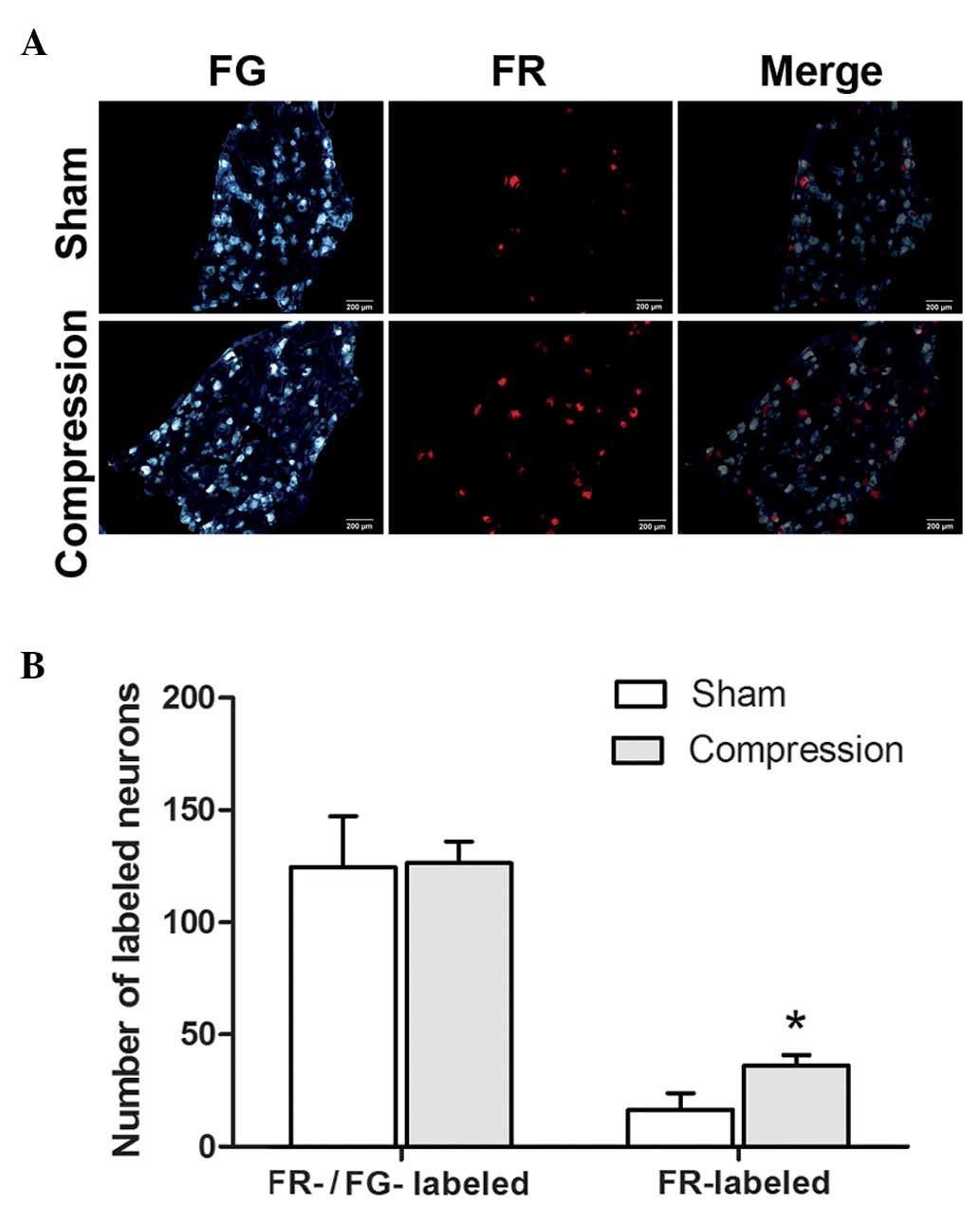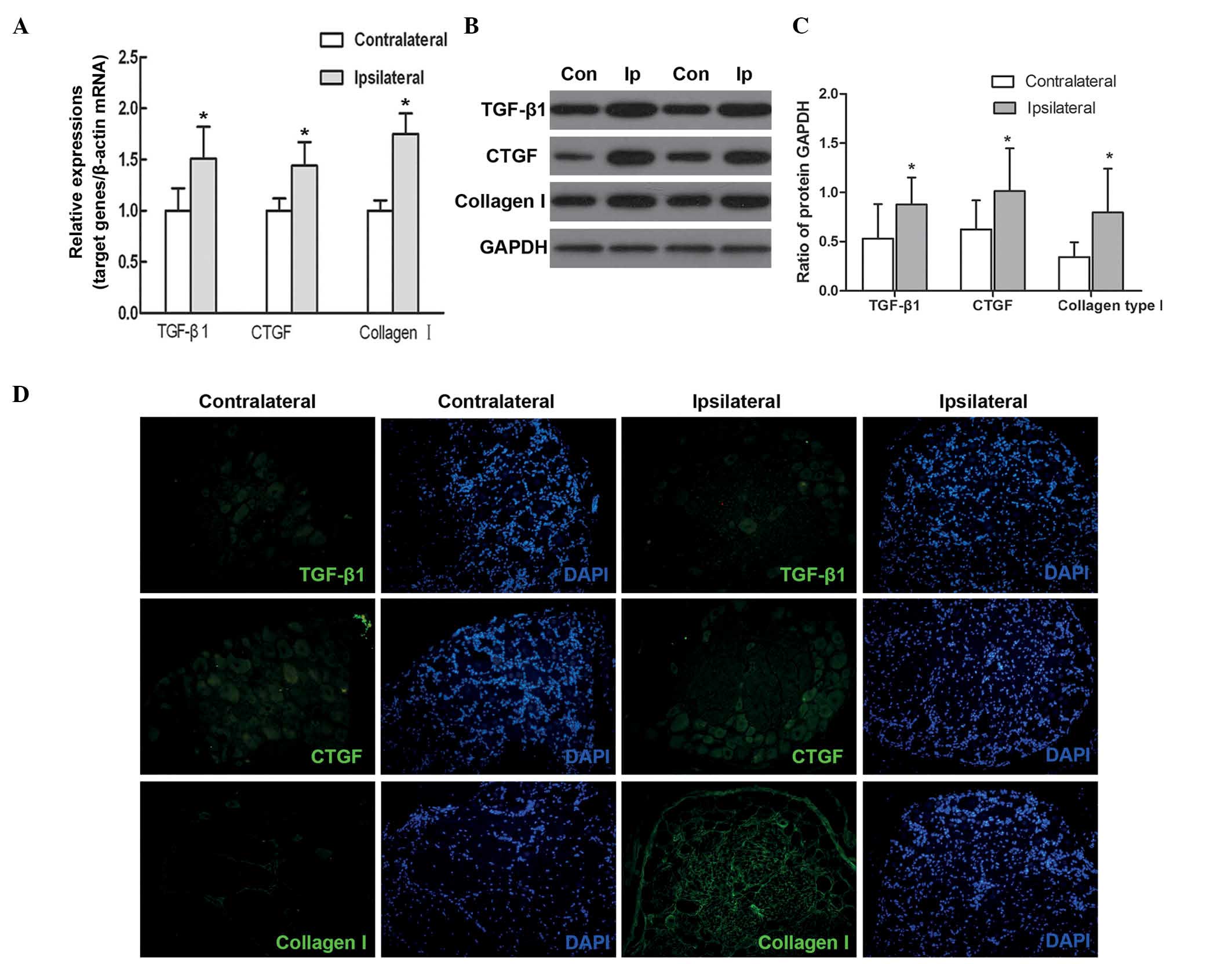|
1
|
Pelletier J, Fromy B, Morel G, Roquelaure
Y, Saumet JL and Sigaudo-Roussel D: Chronic sciatic nerve injury
impairs the local cutaneous neurovascular interaction in rats.
Pain. 153:149–157. 2012. View Article : Google Scholar
|
|
2
|
Berger JV, Knaepen L, Janssen SP, Jaken
RJ, Marcus MA, Joosten EA and Deumens R: Cellular and molecular
insights into neuropathy-induced pain hypersensitivity for
mechanism-based treatment approaches. Brain Res Rev. 67:282–310.
2011. View Article : Google Scholar : PubMed/NCBI
|
|
3
|
Pham K and Gupta R: Understanding the
mechanisms of entrapment neuropathies. Review article. Neurosurg
Focus. 26:E72009. View Article : Google Scholar : PubMed/NCBI
|
|
4
|
Gupta R, Rowshan K, Chao T, Mozaffar T and
Steward O: Chronic nerve compression induces local demyelination
and remyelination in a rat model of carpal tunnel syndrome. Exp
Neurol. 187:500–508. 2004. View Article : Google Scholar : PubMed/NCBI
|
|
5
|
Mackinnon SE: Pathophysiology of nerve
compression. Hand Clin. 18:231–241. 2002. View Article : Google Scholar : PubMed/NCBI
|
|
6
|
Mackinnon SE, Dellon AL, Hudson AR and
Hunder DA: Chronic human nerve compression - a histological
assessment. Neuropathol Appl Neurobiol. 12:547–565. 1986.
View Article : Google Scholar : PubMed/NCBI
|
|
7
|
Prinz RA, Nakamura-Pereira M, De-Ary-Pires
B, Fernandes D, Fabião-Gomes BD, Martinez AM, de Ary-Pires R and
Pires-Neto MA: Axonal and extracellular matrix responses to
experimental chronic nerve entrapment. Brain Res. 1044:164–175.
2005. View Article : Google Scholar : PubMed/NCBI
|
|
8
|
Pham Khoa, Nassiri Nima and Gupta Ranjan:
c-Jun, krox-20, and integrin β4 expression following chronic nerve
compression injury. Neurosci Lett. 465:194–198. 2009. View Article : Google Scholar : PubMed/NCBI
|
|
9
|
Chao T, Pham K, Steward O and Gupta R:
Chronic nerve compression injury induces a phenotypic switch of
neurons within the dorsal root ganglia. J Comp Neurol. 506:180–193.
2008. View Article : Google Scholar
|
|
10
|
Zhang Y, Wang YH, Zhang XH, Ge HY,
Arendt-Nielsen L, Shao JM and Yue SW: Proteomic analysis of
differential proteins related to the neuropathic pain and
neuroprotection in the dorsal root ganglion following its chronic
compression in rats. Exp Brain Res. 189:199–209. 2008. View Article : Google Scholar : PubMed/NCBI
|
|
11
|
Dubovy P, Brazda V, Klusakova I and
Hradilova-Svizenska I: Bilateral elevation of interleukin-6 protein
and mRNA in both lumbar and cervical dorsal root ganglia following
unilateral chronic compression injury of the sciatic nerve. J
Neuroinflammation. 10:552013. View Article : Google Scholar : PubMed/NCBI
|
|
12
|
Ponticos M, Papaioannou I, Xu S, et al:
The failure to degrade JunB contributes to Collagen type I
over-production and dermal fibrosis in Scleroderma. Arthritis
Rheumatol. 1:242–253. 2014.
|
|
13
|
Zhu Y, Colak T, Shenoy M, Liu L, Mehta K,
Pai R, Zou B, Xie XS and Pasricha PJ: Transforming growth factor
beta induces sensory neuronal hyperexcitability and contributes to
pancreatic pain and hyperalgesia in rats with chronic pancreatitis.
Mol Pain. 8:652012. View Article : Google Scholar
|
|
14
|
Fujii M, Nakanishi H, Toyoda T, Tanaka I,
Kondo Y, Osada H and Sekido Y: Convergent signaling in the
regulation of connective tissue growth factor in malignant
mesothelioma: TGF β signaling and defects in the Hippo signaling
cascade. Cell Cycle. 11:3373–3379. 2012. View Article : Google Scholar : PubMed/NCBI
|
|
15
|
Peng B, Chen J, Kuang Z, Li D, Pang X and
Zhang X: Expression and role of connective tissue growth factor in
painful disc fibrosis and degeneration. Spine (Phila Pa 1976).
34:E178–E182. 2009. View Article : Google Scholar
|
|
16
|
Yang Y, Wu H, Yan JQ, Song ZB and Guo QL:
Tumor necrosis factor-α inhibits angiotensin II receptor type 1
expression in dorsal root ganglion neurons via β-catenin signaling.
Neuroscience. 248:383–391. 2013. View Article : Google Scholar : PubMed/NCBI
|
|
17
|
Muralidharan A, Wyse BD and Smith MT:
Analgesic efficacy and mode of action of a selective small molecule
angiotensin II type 2 receptor antagonist in a rat model of
prostate cancer-induced bone pain. Pain Med. 15:93–110. 2014.
View Article : Google Scholar : PubMed/NCBI
|
|
18
|
Obata K and Noguchi K: MAPK activation in
nociceptive neurons and pain hypersensitivity. Life Sci.
74:2643–2653. 2004. View Article : Google Scholar : PubMed/NCBI
|
|
19
|
O'Brien JP, Mackinnon SE, MacLean AR,
Hudson AR, Dellon AL and Hunter DA: A model of chronic nerve
compression in the rat. Ann Plast Surg. 19:430–435. 1987.
View Article : Google Scholar : PubMed/NCBI
|
|
20
|
Zele T, Sketelj J and Bajrovic FF:
Efficacy of fluorescent tracers in retrograde labeling of cutaneous
afferent neurons in the rat. J Neurosci Methods. 191:208–214. 2010.
View Article : Google Scholar : PubMed/NCBI
|
|
21
|
Livak KJ and Schmittgen TD: Analysis of
relative gene expression data using real-time quantitative PCR and
the 2−ΔΔCt method. Methods. 25:402–408. 2001. View Article : Google Scholar
|
|
22
|
Madala SK, Schmidt S, Davidson C, Ikegami
M, Wert S and Hardie WD: MEK-ERK pathway modulation ameliorates
pulmonary fibrosis associated with epidermal growth factor receptor
activation. Am J Respir Cell Mol Biol. 46:380–388. 2012. View Article : Google Scholar :
|
|
23
|
Gao X, Wu G, Gu X, Fu L and Mei C:
Kruppel-like factor 15 modulates renal interstitial fibrosis by
ERK/MAPK and JNK/MAPK pathways regulation. Kidney Blood Press Res.
37:631–640. 2013. View Article : Google Scholar : PubMed/NCBI
|
|
24
|
Ma FY, Tesch GH and Nikolic-Paterson DJ:
ASK1/p38 signaling in renal tubular epithelial cells promotes renal
fibrosis in the mouse obstructed kidney. Am J Physiol Renal
Physiol. 307:F1263–F1273. 2014. View Article : Google Scholar : PubMed/NCBI
|
|
25
|
Kawarai Y, Suzuki M, Yoshino K, Inoue G,
Orita S, Yamauchi K, Aoki Y, Ishikawa T, Miyagi M, Kamoda H, et al:
Transient receptor potential vanilloid 1-immunoreactive innervation
increases in fractured rat femur. Yonsei Med J. 55:185–190. 2014.
View Article : Google Scholar :
|
|
26
|
Lasko L, Huang X, Voorbach MJ, Lewis LG,
Stavropoulos J, Carriker J, Seifert TR, Baker SJ and Upadhyay J:
Multimodal assessment of nervous and immune system responses
following sciatic nerve injury. Pain. 154:2782–2793. 2013.
View Article : Google Scholar : PubMed/NCBI
|
|
27
|
Jones CA, Liang L, Lin D, Jiao Y and Sun
B: The spatial-temporal characteristics of type I collagen-based
extracellular matrix. Soft Matter. 10:8855–8863. 2014. View Article : Google Scholar : PubMed/NCBI
|
|
28
|
Cheret J, Lebonvallet N, Buhe V, Carre JL,
Misery L and Le Gall-Ianotto C: Influence of sensory neuropeptides
on human cutaneous wound healing process. J Dermatol Sci.
74:193–203. 2014. View Article : Google Scholar : PubMed/NCBI
|
|
29
|
Koopmans G, Hasse B and Sinis N: Chapter
19: The role of collagen in peripheral nerve repair. Int Rev
Neurobiol. 87:363–379. 2009. View Article : Google Scholar : PubMed/NCBI
|
|
30
|
Ihn H: Pathogenesis of fibrosis: Role of
TGF-beta and CTGF. Curr Opin Rheumatol. 14:681–685. 2002.
View Article : Google Scholar : PubMed/NCBI
|
|
31
|
Leask A, Holmes A, Black CM and Abraham
DJ: Connective tissue growth factor gene regulation. Requirements
for its induction by transforming growth factor-beta 2 in
fibroblasts. J Biol Chem. 278:13008–13015. 2003. View Article : Google Scholar : PubMed/NCBI
|
|
32
|
Igarashi A, Okochi H, Bradham DM and
Grotendorst GR: Regulation of connective tissue growth factor gene
expression in human skin fibroblasts and during wound repair. Mol
Biol Cell. 4:637–645. 1993. View Article : Google Scholar : PubMed/NCBI
|
|
33
|
Boerma M, Wang J, Sridharan V, Herbert JM
and Hauer-Jensen M: Pharmacological induction of transforming
growth factor-beta1 in rat models enhances radiation injury in the
intestine and the heart. PLoS One. 8:e704792013. View Article : Google Scholar : PubMed/NCBI
|
|
34
|
Sonnylal S, Xu S, Jones H, Tam A, Sreeram
VR, Ponticos M, Norman J, Agrawal P, Abraham D and De Crombrugghe
B: Connective tissue growth factor causes EMT-like cell fate
changes in vivo and in vitro. J Cell Sci. 126:2164–2175. 2013.
View Article : Google Scholar : PubMed/NCBI
|
|
35
|
George J and Tsutsumi M: siRNA-mediated
knockdown of connective tissue growth factor prevents
N-nitrosodimethylami ne-induced hepatic fibrosis in rats. Gene
Ther. 14:790–803. 2007. View Article : Google Scholar : PubMed/NCBI
|
|
36
|
Gressner OA and Gressner AM: Connective
tissue growth factor: A fibrogenic master switch in fibrotic liver
diseases. Liver Int. 28:1065–1079. 2008. View Article : Google Scholar : PubMed/NCBI
|
|
37
|
Stark B, Carlstedt T and Risling M:
Distribution of TGF-beta, the TGF-beta type I receptor and the R-II
receptor in peripheral nerves and mechanoreceptors; observations on
changes after traumatic injury. Brain Res. 913:47–56. 2001.
View Article : Google Scholar : PubMed/NCBI
|
|
38
|
Abreu JG, Ketpura NI, Reversade B and De
Robertis EM: Connective-tissue growth factor (CTGF) modulates cell
signalling by BMP and TGF-beta. Nat Cell Biol. 4:599–604.
2002.PubMed/NCBI
|
|
39
|
Liu Y, Liu Z, Liu X, Luo B, Xiong J, Gan
W, Jiang M and Zhang Z, Schluesener HJ and Zhang Z: Accumulation of
connective tissue growth factor+ cells during the early phase of
rat traumatic brain injury. Diagn Pathol. 9:1412014. View Article : Google Scholar : PubMed/NCBI
|
|
40
|
Petito RB, Amadeu TP, Pascarelli BM,
Jardim MR, Vital RT, Antunes SL and Sarno EN: Transforming growth
factor-β1 may be a key mediator of the fibrogenic properties of
neural cells in leprosy. J Neuropathol Exp Neurol. 72:351–366.
2013. View Article : Google Scholar : PubMed/NCBI
|
|
41
|
Peti W and Page R: Molecular basis of MAP
kinase regulation. Protein Sci. 22:1698–1710. 2013. View Article : Google Scholar : PubMed/NCBI
|
|
42
|
Okada Y, Shirai K, Reinach PS,
Kitano-Izutani A, Miyajima M, Flanders KC, Jester JV, Tominaga M
and Saika S: TRPA1 is required for TGF-β signaling and its loss
blocks inflammatory fibrosis in mouse corneal stroma. Lab Invest.
94:1030–1041. 2014. View Article : Google Scholar : PubMed/NCBI
|
|
43
|
Zhang YP, Wang WL, Liu J, Li WB, Bai LL,
Yuan YD and Song SX: Plasminogen activator inhibitor-1 promotes the
proliferation and inhibits the apoptosis of pulmonary fibroblasts
by Ca (2+) signaling. Thromb Res. 131:64–71. 2013. View Article : Google Scholar
|
|
44
|
Zhang JL, Yang JP, Zhang JR, Li RQ, Wang
J, Jan JJ and Zhuang Q: Gabapentin reduces allodynia and
hyperalgesia in painful diabetic neuropathy rats by decreasing
expression level of Nav1.7 and p-ERK1/2 in DRG neurons. Brain Res.
1493:13–18. 2013. View Article : Google Scholar
|
|
45
|
Zang Y, Xin WJ, Pang RP, Li YY and Liu XG:
Upregulation of Nav1.3 Channel Induced by rrTNF in Cultured Adult
Rat DRG Neurons via p38 MAPK and JNK Pathways. Chin J Physiol.
54:241–246. 2011. View Article : Google Scholar : PubMed/NCBI
|













